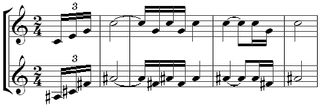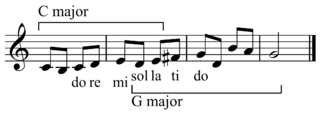
Béla Viktor János Bartók was a Hungarian composer, pianist, and ethnomusicologist. He is considered one of the most important composers of the 20th century; he and Franz Liszt are regarded as Hungary's greatest composers. Through his collection and analytical study of folk music, he was one of the founders of comparative musicology, which later became ethnomusicology.
In music theory, a diatonic scale is any heptatonic scale that includes five whole steps and two half steps (semitones) in each octave, in which the two half steps are separated from each other by either two or three whole steps, depending on their position in the scale. This pattern ensures that, in a diatonic scale spanning more than one octave, all the half steps are maximally separated from each other.
In the theory of Western music, a mode is a type of musical scale coupled with a set of characteristic melodic behaviors. Musical modes have been a part of western musical thought since the Middle Ages, and were inspired by the theory of ancient Greek music. The name mode derives from the Latin word modus, "measure, standard, manner, way, size, limit of quantity, method".

Polytonality is the musical use of more than one key simultaneously. Bitonality is the use of only two different keys at the same time. Polyvalence is the use of more than one harmonic function, from the same key, at the same time.
An octatonic scale is any eight-note musical scale. However, the term most often refers to the symmetric scale composed of alternating whole and half steps, as shown at right. In classical theory, this scale is commonly called the octatonic scale, although there are a total of 42 non-enharmonically equivalent, non-transpositionally equivalent eight-note sets.

The String Quartet No. 4 by Béla Bartók was written from July to September 1928 in Budapest. It is one of six string quartets by Bartok.

In music, modulation is the change from one tonality to another. This may or may not be accompanied by a change in key signature. Modulations articulate or create the structure or form of many pieces, as well as add interest. Treatment of a chord as the tonic for less than a phrase is considered tonicization.
Modulation is the essential part of the art. Without it there is little music, for a piece derives its true beauty not from the large number of fixed modes which it embraces but rather from the subtle fabric of its modulation.
Chromaticism is a compositional technique interspersing the primary diatonic pitches and chords with other pitches of the chromatic scale. Chromaticism is in contrast or addition to tonality or diatonicism and modality. Chromatic elements are considered, "elaborations of or substitutions for diatonic scale members".
Not only at the beginning of a composition but also in the midst of it, each scale-step [degree] manifests an irresistible urge to attain the value of the tonic for itself as that of the strongest scale-step. If the composer yields to this urge of the scale-step within the diatonic system of which this scale-step forms part, I call this process tonicalization and the phenomenon itself chromatic.
Chromaticism is almost by definition an alteration of, an interpolation in or deviation from this basic diatonic organization.
Throughout the nineteenth century, composers felt free to alter any or all chord members of a given tertian structure [chord built from thirds] according to their compositional needs and dictates. Pronounced or continuous chordal alteration [and 'extension'] resulted in chromaticism. Chromaticism, together with frequent modulations and an abundance of non-harmonicism [non-chord tones], initially effected an expansion of the tertian system; the overuse of the procedures late in the century forewarned the decline and near collapse [atonality] of the system [tonality].
Chromaticism is the name given to the use of tones outside the major or minor scales. Chromatic tones began to appear in music long before the common-practice period, and by the beginning of that period were an important part of its melodic and harmonic resources. Chromatic tones arise in music partly from inflection [alteration] of scale degrees in the major and minor modes, party from secondary dominant harmony, from a special vocabulary of altered chords, and from certain nonharmonic tones.... Notes outside the scale do not necessarily affect the tonality....tonality is established by the progression of roots and the tonal functions of the chords, even though the details of the music may contain all the tones of the chromatic scale.
Sometimes...a melody based on a regular diatonic scale is laced with many accidentals, and although all 12 tones of the chromatic scale may appear, the tonal characteristics of the diatonic scale are maintained. ... Chromaticism [is t]he introduction of some pitches of the chromatic scale into music that is basically diatonic in orientation, or music that is based on the chromatic scale instead of the diatonic scales.
The modern Lydian mode is a seven-tone musical scale formed from a rising pattern of pitches comprising three whole tones, a semitone, two more whole tones, and a final semitone.

In music, a closely related key is one sharing many common tones with an original key, as opposed to a distantly related key. In music harmony, there are five of them: they share all, or all except one, pitches with a key with which it is being compared, and is adjacent to it on the circle of fifths and its relative major or minor.
A heptatonic scale is a musical scale that has seven pitches per octave. Examples include the major scale or minor scale; e.g., in C major: C D E F G A B C—and in the relative minor, A minor, natural minor: A B C D E F G A; the melodic minor scale, A B C D E F♯G♯A ascending, A G F E D C B A descending; the harmonic minor scale, A B C D E F G♯A; and a scale variously known as the Byzantine, and Hungarian, scale, C D E♭ F♯ G A♭ B C. Indian classical theory postulates seventy-two seven-tone scale types, collectively called thaat, whereas others postulate twelve or ten seven-tone scale types.

In music theory, the harmonic major scale is a musical scale found in some music from the common practice era and now used occasionally, most often in jazz. In George Russell's Lydian Chromatic Concept it is the fifth mode (V) of the Lydian Diminished scale. It corresponds to the Raga Sarasangi in Indian Carnatic music.
Béla Bartók's Piano Concerto No. 3 in E major, Sz. 119, BB 127 is a musical composition for piano and orchestra. Bartók composed the piece in 1945 during the final months of his life, as a surprise birthday present for his second wife Ditta Pásztory-Bartók. It consists of three movements.
Pitch axis theory is a musical technique used in constructing chord progressions. The tonic is used as the bass note, and melodic scales are chosen according to the chords that lie beneath them. "A variety of scales or modes are used, all built around the same tonic pitch."

In music a distance model is the alternation of two different intervals to create a non-diatonic musical mode such as the 1:3 distance model, the alternation of semitones and minor thirds: C-E♭-E-G-A♭-B-C. This scale is also an example of polymodal chromaticism as it includes both the tonic and dominant as well as "'two of the most typical degrees from both major and minor' ".
In music, the acoustic scale, overtone scale, Lydian dominant scale, or Lydian ♭7 scale, is a seven-note synthetic scale.
In music, the axis system is a system of analysis originating in the work of Ernő Lendvai, which he developed in his analysis of the music of Béla Bartók.
Bimodality is the simultaneous use of two distinct pitch collections. It is more general than bitonality since the "scales" involved need not be traditional scales; if diatonic collections are involved, their pitch centers need not be the familiar major and minor-scale tonics. One example is the opening of Béla Bartók's "Boating" from Mikrokosmos. Here, the right hand uses pitches of the pentatonic scale on E♭ and the left hand uses those of the diatonic hexachord on C, perhaps suggesting G dorian or G mixolydian.
In music, the major Locrian scale, also called the Locrian major scale, is the scale obtained by sharpening the second and third notes of the diatonic Locrian mode. With a tonic of C, it consists of the notes C D E F G♭ A♭ B♭. It can be described as a whole tone scale extending from G♭ to E, with F introduced within the diminished third interval from E to G♭. The scale therefore shares with the Locrian mode the property of having a diminished fifth above the tonic.
Allegro barbaro, BB 63, composed in 1911, is one of Béla Bartók's most famous and frequently performed solo piano pieces. The composition is typical of Bartók's style, utilizing folk elements. The work combines Hungarian and Romanian scales; Hungarian peasant music is based on the pentatonic scale, while Romanian music is largely chromatic.







